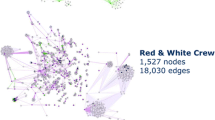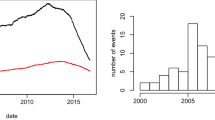Abstract
Most criminal acts are committed in very small groups or alone, and are repeated sporadically. But that is not always the case. Co-offending can include larger groups, cooperating sequentially or simultaneously, knowing each other or at least knowing about one another. We may use the term “extended co-offending” to subsume varieties of crime organization, crime networks, gangs, and criminal clusters. Extended co-offending also includes vaguely organized crime repetitions, and is a matter of degree. Criminal cooperation can be extended in time, space, numbers of persons involved, and types of criminal action. The extension process has a very wide span of possibilities. Drawing ideas from Max Weber and others, this paper suggests that the natural history of criminal cooperation progresses in four stages, with steeply decreasing prevalence: (1) primordial clusters of offenders, (2) small-scale charismatic leadership of offenders, (3) a medium-scale patrimonial system of offenders, and (4) and an extended patrimonial system of criminal cooperation. Primordial co-offending occurs on a very local level, with little or no hierarchy or systematic repetition. Extended criminal cooperation usually requires personal trust among offenders, favoring patrimony over formal organization.
Similar content being viewed by others
References
Albini JL, Rogers RE, Shabalin V, Kutushev V, Moiseev V, Anderson J (1995) “Russian organized crime: its history, structure and function. J Contemp Crim Justice 11(4):213–243
Block AA (1993) Space, Time and Organized Crime. Transaction, New Brunswick
Blok A (1974) The Mafia of a Sicilian village: 1860–1960. Basil Blackwell, Oxford
Bovenkerk F (2000) “Wanted: Mafia boss”—Essay on the personology of organized crime. Crime, Law Soc Chang 33(3):225–242
Felson M (2003) The Process of Co-Offending. In Martha J. Smith Derek B. Cornish, Theory for Practice in Situational Crime Prevention. Monsey NY: Criminal Justice Press (volume 16 in Crime Prevention Studies series). (Available from http://www.popcenter.org/library/crimeprevention/volume_16, accessed May 27, 2008.)
Felson M (2006) The Ecosystem for Organized Crime. HEUNI 25th Anniversary Letcture and 7th Annual Inkiri Anttila Lecutre (HEUNI Paper 26). Helsinki, FI: European Institute for Crime Prevention and Control, Affiliated with the United Nations. (Available from http://www.heuni.fi/uploads/2rreolo2h.pdf, Accessed June 8, 2008.)
Finckenauer JO (1994) Russian organized crime in America. In: Kelly RJ, Chin K-L, Schatzberg R (eds) Handbook of Organized Crime in the United States. Greenwood, Westport
Finckenauer JO (2007) Mafia and organized crime: a beginner’s guide. Oneworld, Oxford
Hess H (1973) Mafia and Mafiosi: The Structure of Power. Lexington, New York
Hess H (1998) Mafia & Mafiosi: Origin, Power, and Myth. New York University Press, New York
Ianni FA, Ianni ER (1972) Family Business: Kinship and Control in Organized Crime. Russell Sage Foundation, New York
Klein MW (1995) The American Street Gang: Its Nature, Prevalence and Control. Oxford University Press, Oxford
Klein MW, Maxson CL, Miller J (eds) (1995) The Modern Gang Reader. Roxbury, Los Angeles
McCord J (2005) Co-offending and Patterns of Juvenile Crime. Research in Brief, December. Washington, DC: National Institute of Justice. (available at http://www.ncjrs.gov/pdffiles1/nij/210360.pdf, accessed May 29, 2008.)
Morselli CK. Petit, and Cynthia Giguère, The Efficiency/Security Trade-off in Criminal Networks. Soc Networks (Forthcoming)
Morselli C, Tremblay P, McCarthy B (2006) Mentors and Criminal Achievement. Criminology 44(1):17–43
Reiss AJ Jr (1988) Co-Offending. and Criminal Careers. In: Morris N, Tonry M (ed) Crime and Justice, vol. 10. University of Chicago, Chicago
Reuter P (1983) Disorganized crime—the economics of the visible hand. MIT, Cambridge
Salter FK (2002) Risky transactions: Trust, Kinship and Ethnicity. Berghan Books, New York
Tremblay P (1993) Searching for Suitable Co-offenders. In: Clarke RV, Felson M (eds) Routine Activity and Rational Choice. Transaction, New Brunswick (Vol. 5 in Advances in Criminological Theory)
von Lampe K (2001) Not a Process of Enlightenment: The Conceptual History of Organized Crime in Germany and the United States of America, Forum on Crime and Society, 1(2), 99–116. (Available from http://www.unodc.org/pdf/crime/publications/forum1vol2.pdf, accessed May 31, 2008.)
von Lampe K, Johansen PO (2004) Organized crime and trust: on the conceptualization and empirical relevance of trust in the context of criminal networks. Glob Crime 6(2):159–184, doi:10.1080/17440570500096734
Warr M (2002) Companions in Crime: The Social Aspects of Criminal Conduct. Cambridge University Press, Cambridge
Weber M (1947 [1918]) (Translated by Talcott Parsons.) The Theory of Social and Economic Organization. Oxford University Press, New York
Zaitch D (2002) Bosses, brokers and helpers. Labour and business relations amongst Colombian cocaine traffickers. Amsterdams Sociologisch Tijdschrift, 29(4), 28 pp., 502–529
Zaitch D (2005) The Ambiguity of Violence, Secrecy and Trust amongst Colombian Drug Entrepreneurs. J Drug Issues 35(1):201–228
Author information
Authors and Affiliations
Corresponding author
Rights and permissions
About this article
Cite this article
Felson, M. The natural history of extended co-offending. Trends Organ Crim 12, 159–165 (2009). https://doi.org/10.1007/s12117-008-9056-7
Received:
Accepted:
Published:
Issue Date:
DOI: https://doi.org/10.1007/s12117-008-9056-7




